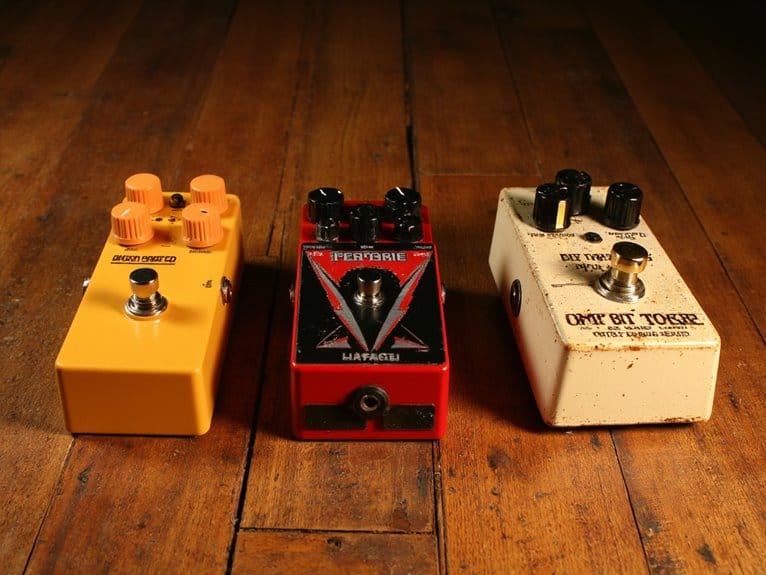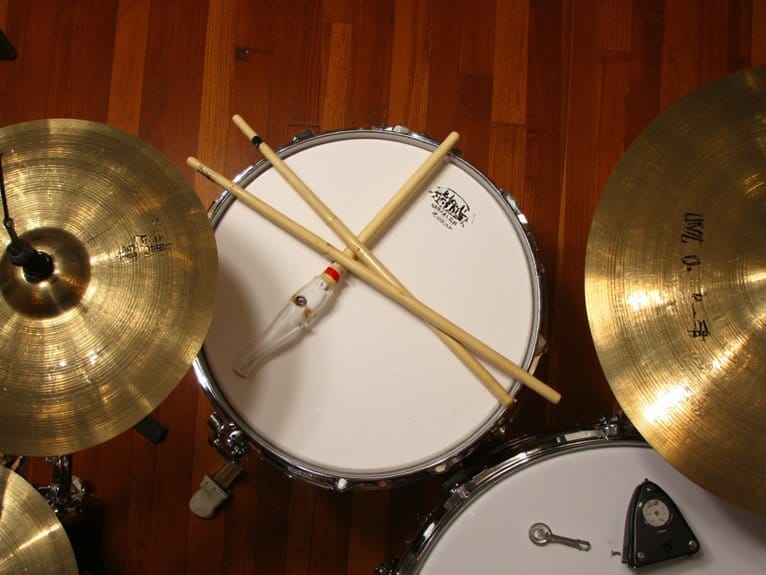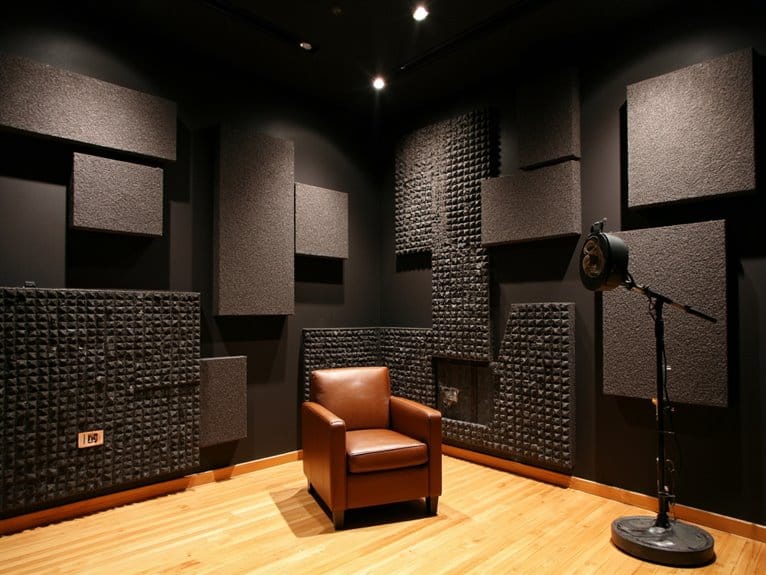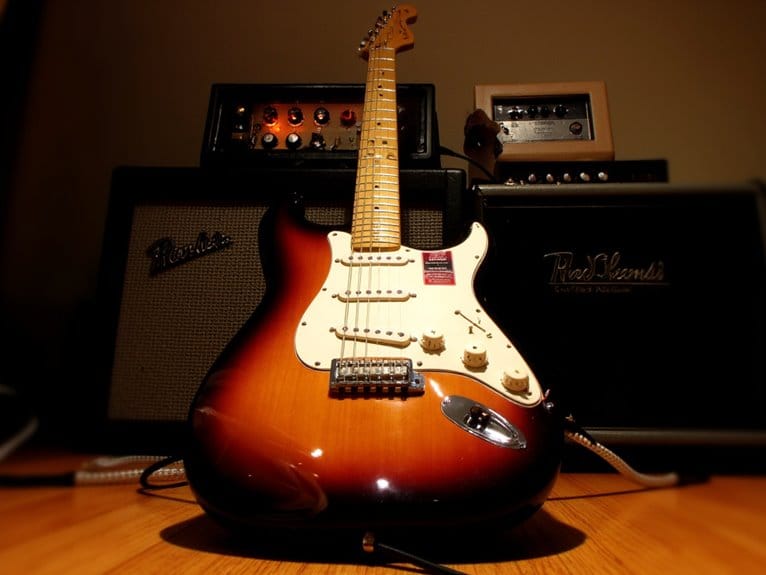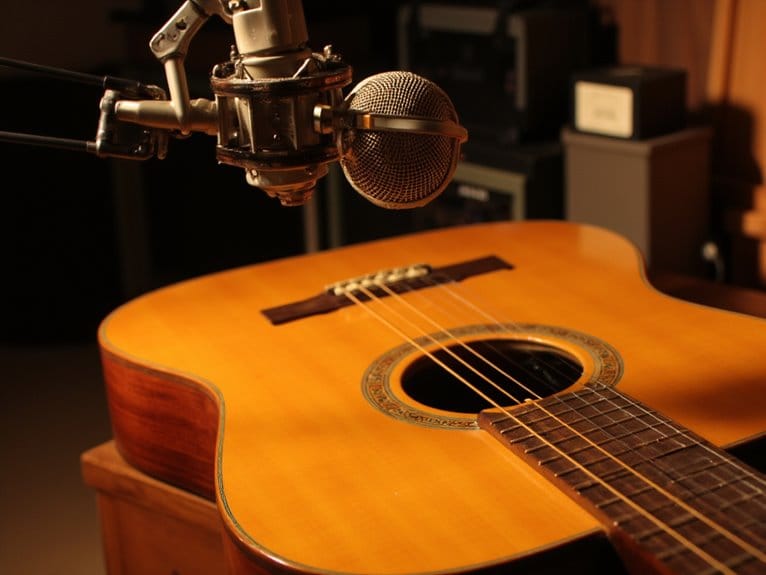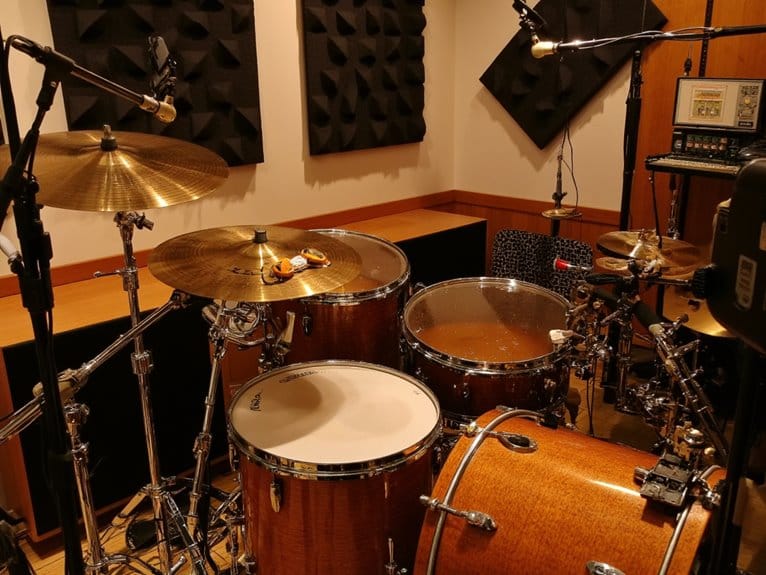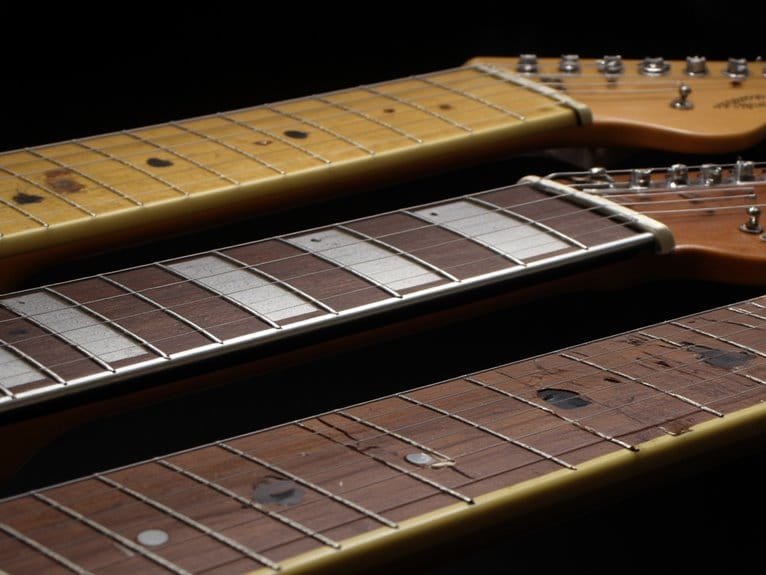Overdrive vs. Distortion vs. Fuzz: Understanding the Differences
You’ll find that overdrive uses soft clipping to preserve your guitar’s natural dynamics and warmth, making it perfect for blues and classic rock, while distortion employs hard clipping for aggressive, compressed sustain that cuts through heavy metal and punk mixes. Fuzz takes a different approach entirely, using transistor-based square-wave clipping to create thick, buzzy textures favored in psychedelic and garage rock. Understanding these circuit differences will transform how you approach your pedalboard setup.
We are supported by our audience. When you purchase through links on our site, we may earn an affiliate commission, at no extra cost for you. Learn more.
Notable Insights
- Overdrive uses soft clipping for warm, natural saturation that preserves guitar dynamics and tone character.
- Distortion employs hard clipping to create aggressive, compressed sustain with consistent harmonically rich output levels.
- Fuzz produces square-wave clipping through transistor circuits, generating thick, buzzy textures with heavy saturation.
- Each effect suits different genres: overdrive for blues/classic rock, distortion for metal/punk, fuzz for psychedelic music.
- Signal chain placement matters: fuzz goes first, followed by distortion, then overdrive to smooth frequencies.
Fundamental Sound Characteristics and Tonal Qualities
Think of overdrive, distortion, and fuzz as three siblings in the same family-they’re all related through their ability to alter your guitar’s signal, but each has developed its own distinct personality over the decades.
Overdrive nuances emerge through soft clipping that preserves your instrument’s natural character, adding warmth without sacrificing tonal preservation or dynamic response.
Soft clipping gently compresses your signal while maintaining the guitar’s organic tone and responsive feel.
Distortion aggression kicks in with hard clipping that produces compressed, harmonically rich sustain perfect for modern rock applications.
Fuzz saturation takes things to extremes with square-wave-like clipping that creates thick, buzzy textures often bordering on synth-like territory. The various harmonics added through clipping greatly impact the tone character, making it essential to understand these differences when selecting the right pedal.
While overdrive maintains note definition and touch sensitivity, distortion compresses heavily for consistent crunch, and fuzz can obscure pitch clarity entirely, making each effect uniquely suited for different musical contexts.
Clipping Methods and Circuit Design Differences
Behind these distinctive tonal personalities lies a fascinating world of electronic engineering, where the specific method used to clip your guitar’s signal determines whether you’ll get overdrive’s warm saturation, distortion’s aggressive bite, or fuzz’s chaotic buzz.
Overdrive pedals employ soft clipping through op-amps or silicon diodes, gradually shaving signal peaks to maintain natural dynamics and touch sensitivity.
Distortion circuits use hard clipping with aggressive diode limiting, creating compressed sustain and consistent output regardless of your playing intensity. The Boss DS-1, a classic distortion pedal since 1978, exemplifies this approach with analog signal processing that delivers versatile sounds from blues to grunge.
Fuzz pedals take a completely different approach, utilizing transistors in common emitter configurations that saturate heavily, producing square wave-like clipping dynamics.
This circuit topology difference explains why fuzz sounds so dramatically different-those transistors operate at their physical limits, generating nonlinear amplification that creates that signature chaotic, lo-fi texture you either love or hate.
Modern multi-effects pedals often incorporate digital modeling algorithms to recreate these analog clipping characteristics, offering guitarists access to overdrive, distortion, and fuzz tones within a single compact unit.
Musical Applications and Genre Preferences
Once you understand how these circuits create their distinctive sounds, the real question becomes where each effect fits into your musical arsenal.
Honestly, genre preferences for overdrive, distortion, and fuzz have evolved into fairly predictable patterns over the decades. Overdrive benefits shine in blues and classic rock, where you’ll want that warm tube amp saturation and touch sensitivity.
Overdrive’s warm tube saturation and touch sensitivity make it the go-to choice for blues and classic rock guitarists.
Distortion drawbacks include losing some dynamic range, but metal and punk players embrace that compressed aggression for powerful rhythm work.
Fuzz versatility appears in psychedelic and garage rock, though its extreme compression can flatten your playing dynamics. This genre evolution reflects each effect’s sonic DNA-overdrive preserves your guitar’s natural character, distortion adds thickness and edge, while fuzz creates that distinctive buzzy texture perfect for experimental soundscapes.
Signal Chain Placement and Effect Interactions
Understanding how these effects shape your sound becomes only half the equation when you’re actually wiring up your pedalboard, because signal chain placement dramatically affects how overdrive, distortion, and fuzz interact with each other and your other effects.
I’ve learned that fuzz pedals work best early in the chain, directly after your guitar, since they’re incredibly sensitive to signal impedance and don’t play well with buffers. Distortion typically follows fuzz, while overdrive comes last among gain effects to smooth out harsh frequencies. Treble boosters should be positioned first in your signal chain to shape your core tone before other pedals process the signal.
These effect interactions create entirely different tonal characteristics-placing overdrive after distortion acts like a dynamic tone shaper, adding warmth and reducing fizz, while reversing the order produces brighter, more aggressive results.
Choosing the Right Dirt Pedal for Your Style
Which dirt pedal you choose ultimately depends on your musical style, playing technique, and the sonic character you’re trying to achieve, because each type of gain effect serves fundamentally different purposes in your overall sound.
If you’re drawn to classic rock, blues, or country, overdrive’s warm, dynamic response will complement your player styles perfectly, especially if you prefer controlling gain through picking intensity.
Heavy rock and metal players typically gravitate toward distortion for its consistent, aggressive saturation that cuts through dense mixes.
Distortion’s aggressive saturation and consistent gain make it the go-to choice for heavy rock and metal guitarists.
Meanwhile, if your tonal preferences lean toward psychedelic, funk, or experimental music, fuzz delivers that harmonically rich, compressed sustain you’re after.
Consider your amp’s natural breakup characteristics too-overdrive works beautifully with tube amps, while distortion provides reliable saturation regardless of your amplifier’s inherent voice.
On a final note
You’ve now got the roadmap to navigate the dirt pedal landscape, though I’ll admit the sheer number of options can still feel overwhelming. Whether you’re chasing that smooth, tube-amp breakup with overdrive, the aggressive midrange bite of distortion, or fuzz’s wild, saturated chaos, your musical style and existing gear will guide your choice. Trust your ears, experiment with different pedals, and remember that there’s no wrong answer-only different flavors of awesome.

